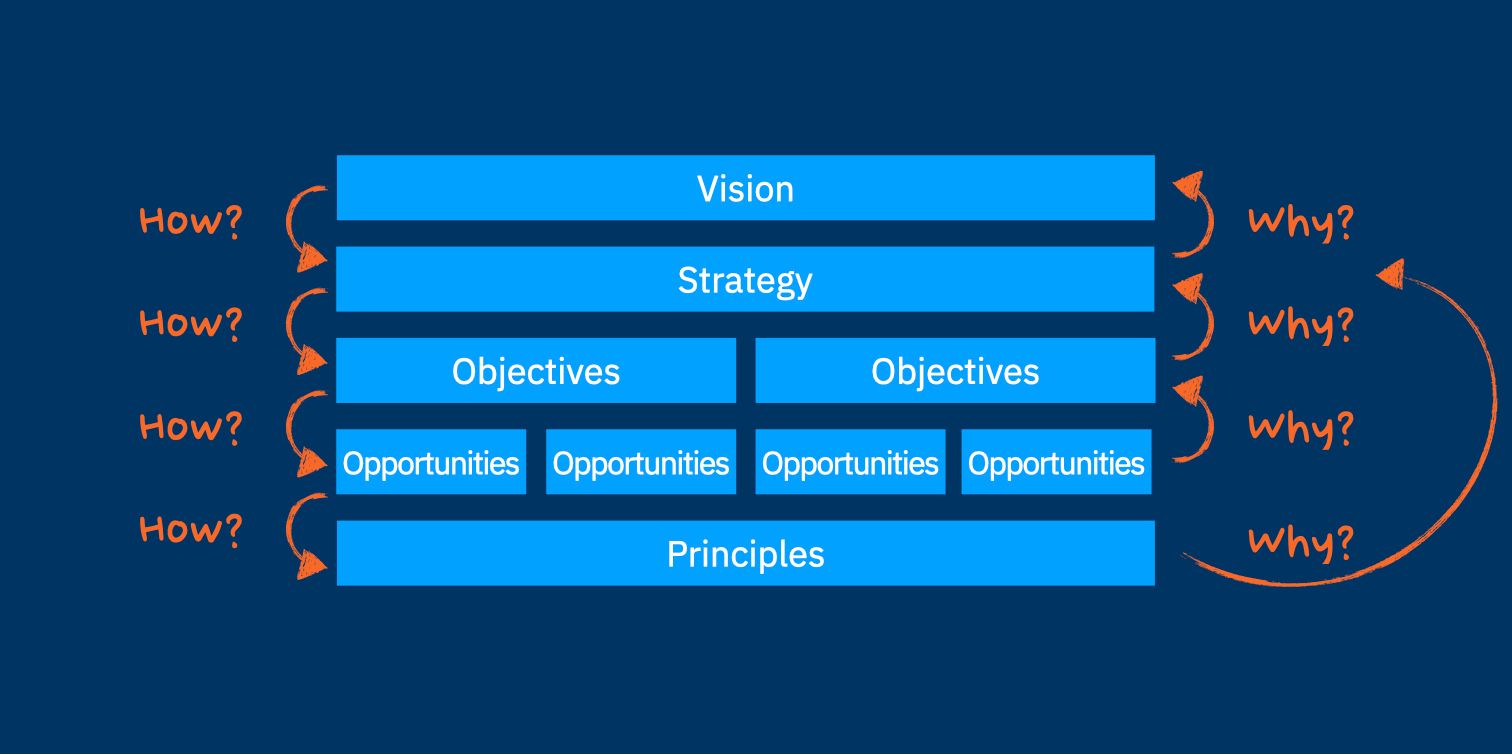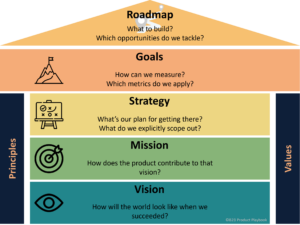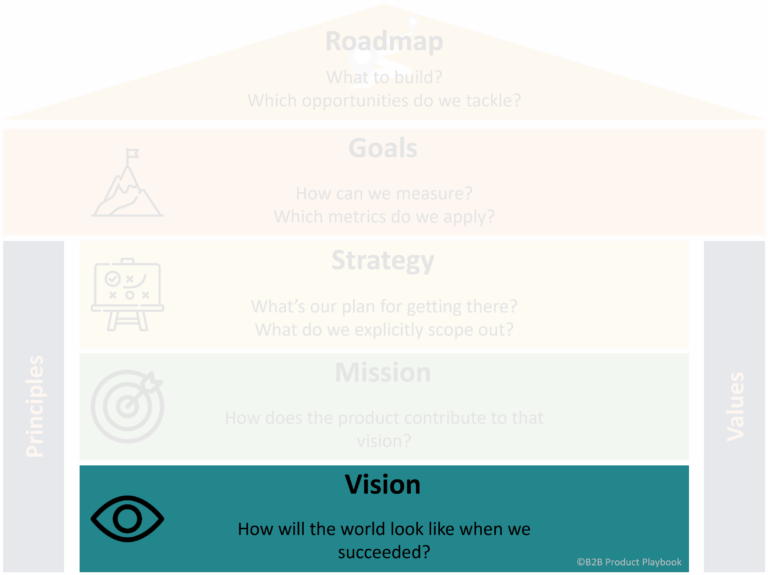Purpose & Vision
In part 2 of this playbook, we will explain how purpose, vision, mission, strategy, and roadmap are connected to each other and how each of these can be utilized to guide in the next phase, from highly strategic to more tactical steps.
Clarifying Terminology
Specifically, mission and vision are oftentimes used interchangeably: Find 5 different sources and they will come up with 7 different definitions 😖. To give a particularly poor example:
A mission statement is a short statement of why an organization exists, what its overall goal is, identifying the goal of its operations: what kind of product or service it provides, its primary customers or market, and its geographical region of operation. It may include a short statement of such fundamental matters as the organization's values or philosophies, a business's main competitive advantages, or a desired future state—the "vision".
So, according to this Wikipedia article, a mission statement is short and crisp — yet describes all the details including purpose, operations, details about customers, markets, geographies, and even competitive advantages. We believe this is just totally confusing and, hence, fails to act as a guide in understanding and creating all these pillars.
Instead, in the following chapters of this playbook, we will assume a framework where:
- the vision is used to express the purpose of the company, the reason why it exists
- the (product) mission details how that vision is supported by the product
- the strategy lays out specific steps toward that vision,
- values & principles describe the beliefs and philosophies driving the business, and
- product goals as well as roadmap items on the tactical level are aligned alongside the strategy.
Company Vision Statement
We envision a world in which...
Our purpose is to create a world in which...
where they don’t even talk about the company itself but rather about how the world will look like once they have succeeded. To illustrate, consider the following popular quote and see how it replaces the assignment of specific tasks with an overarching goal:
If you want to build a ship, don’t drum up the men to gather wood, divide the work, and give orders. Instead, teach them to yearn for the vast and endless sea.
Antoine de Saint-Exupéry
In other words:
A vision statement outlines the long-term aspirations and describes the overarching goals that an organization aims to achieve. The statement is broad, inspirational, and looking into the future thus providing a sense of direction without prescribing tactics.
The vision is the foundation for all subsequent steps, for defining the product mission and strategy as well as deriving areas to work on, as we shall see in the following. It is essential that the vision statement, when used externally with customers, is consistent with the behavior of the company.
Some may argue that a vision statement should be bold enough to serve for a lifetime, but at least it should express a long-term goal, so be valid for more than a decade.
Importance of a Vision Statement
- It helps to align the internal team towards a common goal.
- It attracts investors based on some easy-to-grasp future potential.
- It attracts talent who identify with the purpose.
- It may even help win customers who share the same purpose, vision, and principles.
During his visit to the NASA space center, as the story goes, President John F. Kennedy noticed a janitor carrying a broom. He interrupted his tour, walked over to the man and asked: “What are you doing?” “Well, Mr. President,” the janitor responded, “I’m helping to put a man on the moon.”
You Cannot Over-Communicate
A vision statement that isn’t known by employees is rather useless. Once it has been created, it is crucial that it’s clearly and repeatedly communicated across the entire organization and beyond. In fact, we believe that any major product meeting, such as planning events or reviews, should be started with the vision, mission, and strategy to reinforce its importance and maintain visibility.
Beyond meetings, visual reminders also help: screensavers, posters, or digital displays prominently placed in common areas will serve as constant reminders and reinforce the vision in the daily work environment so that employees stay connected to long-term goals.
What Should Not Be in a Vision
Most importantly, a vision statement shouldn’t be talking about the company itself: how the company will become successful, be a market leader, beat the competition, or make a ton of revenue. None of these internal aspects should be part of the vision. Instead, the focus shall be purely on the impact on the outside world, on how the lives of users will improve, or how a major problem of mankind will be solved.
Also, a mission statement shall not include any details — be it on execution, timeline, internal organization, or else. See the quote from Wikipedia at the beginning of this chapter as a rather bad example.
Examples
In the following, we will comment on some more or less great examples of vision statements (even though some of these companies list these as mission statements — confirming the confusion mentioned in the introduction of this chapter). Sometimes, companies leave out visions and start with the mission right away. It seems like this is often the case when they are not so much looking into a bright new future but focusing on what they can deliver today already — see McDonald’s, for example:
Ten Great Examples
To make people happy.
Disney
While it had been updated recently, this originally was a great vision, purely looking at how customers feel. Note how it covers all kinds of entertainment, from animations to movies to amusement parks.
To create a better everyday life for the many people.
IKEA
Another great vision, maybe a bit broad, far beyond home furnishing, so details will be needed when narrowing down toward the mission and strategy level.
To create economic opportunity for every member of the global workforce.
Clearly mentioning the target group and how they shall benefit without limiting to a social network.
To make delicious feel-good moments easy for everyone.
McDonald's
Well, this probably depends on personal taste…😉
To empower every person and every organization on the planet to achieve more.
Microsoft
Note how this doesn’t speak about Windows or Office 365, or even software at all. Just like the IKEA example above, it’s fairly broad so will need more details later on.
To bring inspiration and innovation to every athlete in the world.
Nike
By way of a footnote that declares every human with a body as an athlete, the vision actually focuses on the activity rather than just professional athletes.
We exist to help our customers feel good and look their best.
NordStrom
Even without knowing them, one can imagine it’s all about fashion, jewelry, and cosmetics.
A just world without poverty.
Oxfam
A perfect and noble example of a highly inspirational vision statement.
To make commerce better for everyone.
Shopify
A clear focus on improving everybody’s life around (e-)commerce.
To accelerate the world’s transition to sustainable energy.
Tesla
Note how this goes beyond just electric vehicles. It clearly also covers solar panels — but is a different business than SpaceX.
And a Few Not-so-good Ones
We bring together all the necessary technology and services, regardless of where those solutions come from, to help clients solve the most pressing business problems.
IBM
Hmmm 🤔. Why start with “we” instead of the benefits for clients?
To help the world run better and improve people’s lives with sustainability at the core.
SAP
Who would imagine this to be business software and ERP? Sounds more like a competitor to Nike and Adidas?
Using our unlimited passion for technology, content and services to deliver groundbreaking new excitement and entertainment, as only Sony can.
Sony
OK, just 2 words about the customers. The rest is about the company.
We reimagine the way the world moves for the better.
Uber
Maybe a good vision statement. The question is, however, whether business practice keeps up to that promise.
Further Reading

The Decision Stack
Connecting the dots between vision, mission, objectives, and principles through The Decision Stack is the best way to align your business and enhance the autonomy of your product teams by giving agency to everyone to make better decisions, faster.


